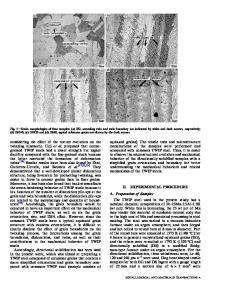The Effect of Long-Term Thermal Exposure on the Microstructure and Stress Rupture Property of a Directionally Solidified
- PDF / 3,920,080 Bytes
- 11 Pages / 593.972 x 792 pts Page_size
- 88 Downloads / 299 Views
NTRODUCTION
THE materials applied in industrial gas turbine blades are expected to withstand high temperature and stress during long-term service. It is reported that the proper examining and repairing interval of gas turbine blades is 24,000 equivalent operation hours (EOH) and the total service life is beyond 50,000 EOH.[1,2] Extensive studies have shown that prolonged thermal and stress exposure causes multiple microstructural degradations such as c¢ coarsening and rafting, MC carbides decomposition, secondary precipitations along grain boundaries, and formation of TCP phases and cavity or void in the gas turbine blades after long-term service, almost all of which are detrimental to mechanical properties.[3–5] The morphologies and mechanisms associated with c¢ particle coarsening upon aging have been a topic of significant discussion over the past decades.[6–10] Since the changes in morphology, size, and distribution of c¢ precipitates during long-term thermal exposure mainly cause the degradation of tensile strength and creep resistance, it is very important to monitor the evolution of c¢, be able to predict the kinetics of growth during long-term thermal exposure, and correlate that with mechanical properties. However, the evolution of size/ morphology and volume fraction of c¢ precipitates during long-term thermal exposure beyond 20,000 hours X.W. JIANG, Ph.D. Candidate, D. WANG, Assistant Researcher, G. XIE, Associate Researcher, and H. LI and L.H. LOU, Professors, are with the Superalloys Division, Institute of Metal Research, Chinese Academy of Sciences, 72 Wenhua Road, Shenyang 110016, P. R. China. Contact e-mail: [email protected] J. ZHANG, Professor, is with the Superalloys Division, Institute of Metal Research, Chinese Academy of Sciences, and also with the Shenyang National Laboratory for Materials Science, Institute of Metal Research, Chinese Academy of Sciences, 72 Wenhua Road, Shenyang 110016, P.R. China. Manuscript submitted March 4, 2014. Article published online September 17, 2014 6016—VOLUME 45A, DECEMBER 2014
and its impact on the creep properties of superalloys have been seldom reported in previous studies. Compared to single crystal (SC) Ni-based superalloys, directional solidification (DS) Ni-based superalloys have a particular creep deformation characteristic due to MC decomposition in grain boundary (GB) region and grain boundary precipitates coarsening during long-term thermal exposure. Unfortunately, limited information is available for the coarsening kinetics of grain boundaries and the effects on creep property of DS Ni-based superalloys during long-term thermal exposure. It is interesting to note that most of the above microstructural evolutions are reversible, in the sense that they can be rejuvenated by re-heat treatment and hot isostatic pressing (HIP).[11,12] Unfortunately, primary MC decomposition is irreversible and may affect the microstructure stability and mechanical properties of the rejuvenated blades during the next service cycle.[4,11–13] Three classical reactions, MC + c fi M2
Data Loading...











